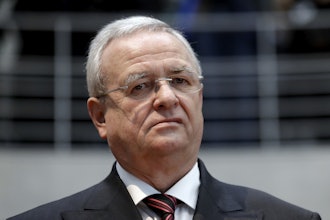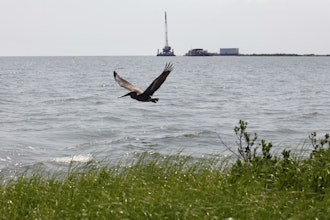| Motor-side view of the BalaDyne fan balancing system (perpendicular to motor) installed at Dacotah Cement. |
As a result, every two months, Dacotah had to shut down the plant to sandblast accumulated material from the fan. The cleaning often took six hours and, by the time the kiln was back in service, 12 hours of production were lost. "When demand is high, each ton of clinker we lose is critical," says Black. "We can't make it up by running the plant an extra day or by speeding it up. Our equipment must run 24/7. If we're down for 12 hours, that's 1,000 tons of clinker lost."
The shutdowns also damaged the kiln's refractory lining. Repeated heating and cooling caused sections of it to fail, which meant additional repairs.
Dacotah turned to the Michigan-based BalaDyne division of Lord Corp., Cary, NC. BalaDyne designs and manufactures industrial balancing systems. The company makes an automatic fan-balancing system that continuously monitors and corrects unbalanced conditions. The system's balancing head mounts directly to the fan's shaft. The head is divided into four chambers that contain a high-specific-gravity balancing fluid. When the balancer's controller detects an imbalance, the chamber fluid on the heavy side heats up, changing from a liquid to a gas. The gas transfers through a shuttle tube to the chamber on the light side where it condenses and returns to a liquid. This process continues until the controller senses that balance has been restored. A non-contact power supply eliminates the need for maintenance, sending power and data across an air gap between a stationary primary coil and a rotating secondary coil.
While the solution was good, it was apparent that installing the balancer in Dacotah's kiln would not be easy. Limited space and the presence of heat radiating from the nearby 650-degree F process air stream presented significant problems. BalaDyne solved them by tailoring the balancing wheel to fit the available space, and designing a cooling fan and ventilation holes into the balancer's housing. More ventilation was provided by an externally mounted blower.
Dacotah also installed an optional B4Setup for Windows software, which helps analyze fan vibration and predict future problems. Data stored in the fan-balancer controller can be retrieved and analyzed. The software also calculates a "fan signature," which measures the frequency response through the entire rotor operating-speed range, detecting problems inherent in the fan structure, including fan-resonant frequencies, shaft misalignment, and others.
Prior to installing the balancer, the fan's vibration would reach levels up to 20 mils. The balancing system currently maintains vibration levels between 0.8 and 1.2 mils. The system continually corrects for fan imbalances caused by particulate build up and spalling. The result: extended plant runs, reduced maintenance costs, and increased clinker production.
"With the BalaDyne balancing system, our fan stays in balance," says Black, "and only has to be cleaned during scheduled plant shutdowns. It eliminates the lost-production factor. The fan has worked so well that we had a second system installed."
BalaDyne Corp., 1665 Highland Dr., Ann Arbor MI 48108; 734-973-8300.






















